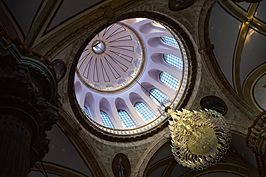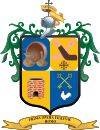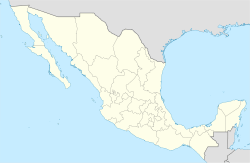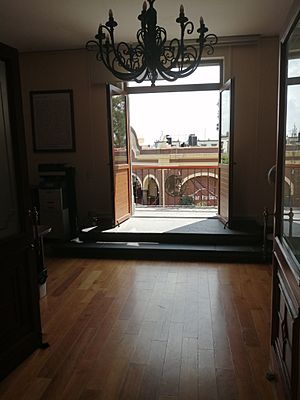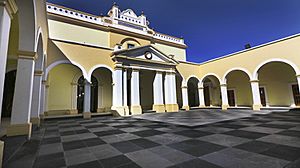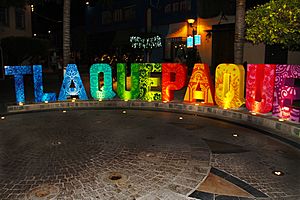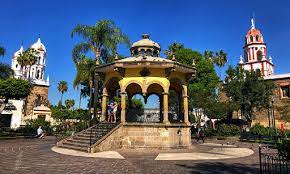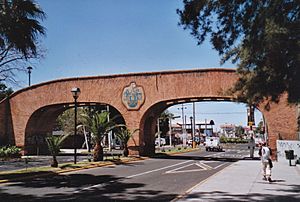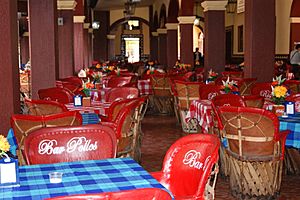Tlaquepaque facts for kids
Quick facts for kids
Tlaquepaque
|
|||
|---|---|---|---|
| San Pedro Tlaquepaque | |||
|
Sanctuary of La Soledad, San Pedro Parish, Historical House, Regional Ceramic Museum, El Parian and the interior of the Sanctuary of La Soledad
|
|||
|
|||
| Nickname(s): | |||
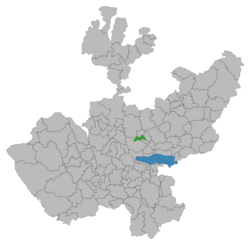 |
|||
| Country | |||
| State | |||
| Region | Centro | ||
| Municipality | Tlaquepaque | ||
| Foundation | 25 March 1530 | ||
| Area | |||
| • City | 82.04 km2 (31.68 sq mi) | ||
| • Metro | 3,571 km2 (1,379 sq mi) | ||
| • Municipality | 116.8 km2 (45.1 sq mi) | ||
| Elevation | 1,870 m (6,140 ft) | ||
| Population
(2020 census)
|
|||
| • City | 650,123 | ||
| • Density | 7,924.5/km2 (20,524.3/sq mi) | ||
| • Metro | 5,268,642 | ||
| • Metro density | 1,475.40/km2 (3,821.3/sq mi) | ||
| • Municipality | 687,127 | ||
| • Municipality density | 5,882.9/km2 (15,237/sq mi) | ||
| Demonym(s) | Tlaquepaquense | ||
| Time zone | UTC−6 (CST) | ||
| • Summer (DST) | UTC−5 (CDT) | ||
| Website | https://www.tlaquepaque.gob.mx/ | ||
Tlaquepaque (pronounced tlah-keh-PAH-keh), officially called San Pedro Tlaquepaque, is a lively city and municipality in the Mexican state of Jalisco. It's famous for its beautiful pottery and blown glass.
Contents
Discover Tlaquepaque's Location
Tlaquepaque is very close to Guadalajara, the capital city of Jalisco. It has grown so much that it's now part of the big Guadalajara city area. In 2010, about 575,942 people lived here. This makes it the third-largest city in the state. The municipality covers about 270.88 square kilometers (104.59 sq mi). It sits just south of Guadalajara.
Tlaquepaque's Weather
The weather in Tlaquepaque is mostly dry. Winters and springs are dry, but the rest of the year is warm. The average temperature is about 20.7°C (69.3°F). Most of the rain falls from June to August. Winds usually blow from the southeast. On average, there are only about 5 frosty days each year.
Nature in Tlaquepaque
Tlaquepaque has some small forest areas. You can find trees like acacia and palo dulce there. Wild animals include rabbits, hares, squirrels, and different kinds of reptiles. Many types of birds also live in the region.
Water and Land
There are no big rivers in Tlaquepaque. It has smaller streams like La Pila Seca. Most of the land is used for buildings and homes. The ground is made of volcanic ash and pumice stone.
What Tlaquepaque Makes
Tlaquepaque is known for its strong economy.
Farming and Ranching
Farmers here grow crops like maize (corn), sorghum, sweet potato, and onion. Ranchers raise animals such as cows (for meat and milk), pigs, sheep, and goats. They also have poultry farms for chickens and bees for honey.
Crafts and Industry
The city is famous for its amazing handicrafts. Artists create beautiful items from papier-mâché, glass, brass, and clay. They also work with yarn, leather, and wood. Tlaquepaque is home to several industrial parks. Big companies like HP (printers), Bimbo (bread), Lala (dairy), and José Cuervo (tequila) have factories here.
A Look Back in Time
The name Tlaquepaque comes from the Nahuatl language. It means "place above clay land." This makes sense because the area is famous for its pottery.
Before the Spanish arrived, Tlaquepaque was part of a kingdom. This kingdom was ruled by a woman named Cihualpilli Tzapotzinco. It was home to the Tonalteca and Tecos people. In March 1530, a Spanish explorer named Nuño de Guzmán came to the area. Some local leaders wanted peace, while others wanted to fight. The peace group, including leaders from Tlaquepaque, welcomed Guzmán.
On March 25, 1530, Nuño de Guzmán took control of the kingdom. In 1548, the town was renamed San Pedro. This name was suggested by a religious leader, Fray Antonio de Segovia. For a long time, it was known only as San Pedro.
In 1810, Miguel Hidalgo y Costilla, a key figure in Mexico's independence, visited San Pedro. He was welcomed with a big celebration. In 1821, San Pedro Tlaquepaque was where the Independence of Jalisco was declared. This important document was signed here on June 13, 1821.
Cultural Center El Refugio
In 1859, a hospital and spiritual center called "El Refugio" was built. It was supported by donations from the community and wealthy families. The building has a colonial style with long hallways and large courtyards.
In 1979, El Refugio closed. After being empty for a while, the city bought it in 1983. It was then renovated and reopened in 1984 as the Cultural Center "The Refuge." Today, it's a place for cultural events, art, crafts, and tourism. It also houses the School of Plastic Arts and the Museum of the National Prize for Ceramics.
Fun Things to Do in Tlaquepaque
In 2018, Tlaquepaque was named a "Pueblo Mágico" (Magical Town). This means it's a special place known for its culture and beauty. It's a great spot to see pottery, textiles, and blown glass being made. Its streets have old houses and colonial buildings. The Tapatío Tour bus even stops here!
- St. Peter's Parish: This church was built by the Franciscan Order. It became a parish in 1845. Its design mixes different styles like Byzantine, Baroque, and Roman.
- Jardín Hidalgo: This is a lovely garden with a main square and a kiosk. It's surrounded by palm trees, ash trees, and roses.
- Municipal Palace: This old colonial building from the 1800s is now the city's government office. You can see amazing murals inside, like "Historia de Fuego" and "Yolotl."
- El Parián: This famous building is a popular spot for families. It's a place for gatherings and celebrations. It has 18 restaurants and bars.
- Andador Independencia: This walking street is full of art galleries, craft shops, and old houses. You'll also find the Regional Ceramics Museum, bars, and restaurants here.
- El Refugio Cultural Center: This large building, once a hospital, is now a center for events and exhibitions. It also has art and craft schools and the Pantaleón Panduro Ceramics Museum.
- Regional Ceramics Museum: This museum has eight rooms filled with pottery from different parts of Jalisco and Mexico. It even has tiny miniature pieces by Angel Carranza.
- Sanctuary of the Holy Mexican Martyrs: This sanctuary remembers Mexican martyrs who gave their lives for their faith. Many of them were from Guadalajara.
Main Sights to Explore
Jardín Hidalgo ("Hidalgo Garden")
This is the main plaza in the city center. It's named after a large statue of Miguel Hidalgo y Costilla, who is known as the "Father of Mexican Independence."
Other important places here include two churches: the Santuario de Nuestra Señora de la Soledad (Sanctuary of Our Lady of Solitude) and the Parroquia de San Pedro Apóstol (Saint Peter Parish). There's also the Benito Juárez market nearby.
Tlaquepaque's Culture
Tlaquepaque is well-known for its lively mariachi bands. During the yearly San Pedro festivities, Jardín Hidalgo fills with stalls and street vendors. On San Pedro's day, huge structures decorated with fireworks, called the Castillo ("castle") and Toro ("bull"), are lit up.
What Does the Name Mean?
The name "Tlaquepaque" comes from the local land. It means "Place on knolls of clay land." Other ideas suggest it means "men who craft clay pieces." Some believe it comes from "Tlalipac," meaning "on mud knolls," or simply "place of mud."
Getting the Original Name Back
In 1843, San Pedro Tlaquepaque was given the title of "Villa." But in 1917, a rule was made in Jalisco that stopped using saints' names for places. So, "San Pedro" was dropped from the name.
However, the people of Tlaquepaque wanted their full name back. In 2010, the city held a survey. More than 13,000 people voted, and 62.4% wanted to bring back "San Pedro Tlaquepaque." Because of this, on September 27, 2011, the state government approved the change. So, the municipality officially became San Pedro Tlaquepaque again!
Tlaquepaque is also famous for its delicious tepache. This is a slightly fermented drink made from pineapple, brown sugar, and water.
Sister Cities
 Antigua Guatemala, Guatemala
Antigua Guatemala, Guatemala Atwater, California, United States
Atwater, California, United States Cancún, Quintana Roo, Mexico
Cancún, Quintana Roo, Mexico Glendale, California, United States
Glendale, California, United States Metepec, State of Mexico, Mexico
Metepec, State of Mexico, Mexico Oaxaca, Oaxaca, Mexico
Oaxaca, Oaxaca, Mexico Old Havana, Cuba
Old Havana, Cuba San Joaquín, Querétaro, Mexico
San Joaquín, Querétaro, Mexico San Miguel de Cozumel, Quintana Roo, Mexico
San Miguel de Cozumel, Quintana Roo, Mexico Springfield, Missouri, United States
Springfield, Missouri, United States Zapotiltic, Jalisco, Mexico
Zapotiltic, Jalisco, Mexico
Images for kids
See also
 In Spanish: San Pedro Tlaquepaque para niños
In Spanish: San Pedro Tlaquepaque para niños







